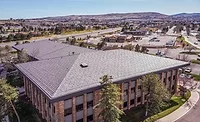Denver Botanic Gardens: Cement Composite Panels Form Roof and Walls of Science Pyramid
The Science Pyramid at Denver Botanic Gardens invites visitors to explore the relationship between people and plants, and to examine the role of biomimicry in our lives — the way the features of nature inspire ideas and actions in people.
It’s not surprising then that the building would have a great relationship with its surroundings. Rising to a comfortable height among the area's ground-level structures, the angles and scale of the 34-foot-high pyramid are almost a mirror image of the Garden’s amphitheater to which it sits next.
From the outside, a pyramid appears smaller than it actually is, but from the inside it appears much bigger than it is. Fittingly, the Science Pyramid presents a bigger view of the world of horticulture, using interactive technology to engage visitors with Botanic Garden’s environmental research into the semi-arid, cold-winter steppe regions of the world, which includes Colorado, and showing them how their own backyard is connected to the larger natural world.
The 5,258-square-foot structure has 16 sides consisting of hexagonal panels in a honeycomb design, with painted steel and angular windows. The exterior is covered in a dark gray cement composite panel material by Swisspearl®, often used as siding but here used as a roof material for the first time. Below the rainscreen, the roof features six inches of insulation, taking its cue from cold-roofing projects seen in the mountains.
Pyramid shapes present a challenge because the enclosures are both roof and wall. The shape, usage, cladding and climate multiply the complex dimensions of maintaining a watertight exterior while managing the moisture generated within.
Additionally, the open joints expose the membrane behind the cladding. For this project, the water-resistive barrier (WRB) has to provide all the performance criteria of a regular WRB along with long-term resistance to UV light and the impact of wind, rain and snow. The extremes of Denver’s winter and summer climate made the performance requirements even more stringent.
DELTA®-VENT SA provides the primary protection at the plywood substrate. Because of its high vapor permeability, it prevents significant interior moisture build-up while remaining watertight. Because it’s also a fully adhered air barrier, an energy-efficient airtight enclosure could be built without the risk of leakage from fasteners.
DELTA-FASSADE S provided the final weatherproofing step. It has extremely high UV resistance so the light coming through the open joints will not degrade its weatherproofing qualities. It’s also watertight yet highly vapor permeable. The insulation that lies underneath will stay reliably dry and functioning at maximum R-value.
Working together, the two products ensure a watertight enclosure that also manages moisture in a complex climate. The flat black of the DELTA-FASSADE S also enhances the beauty of the Science Pyramid, adding depth and dimensionality that heightens the striking appearance of this landmark building.
For more information, visit www.cosella-dorken.com.
Looking for a reprint of this article?
From high-res PDFs to custom plaques, order your copy today!





